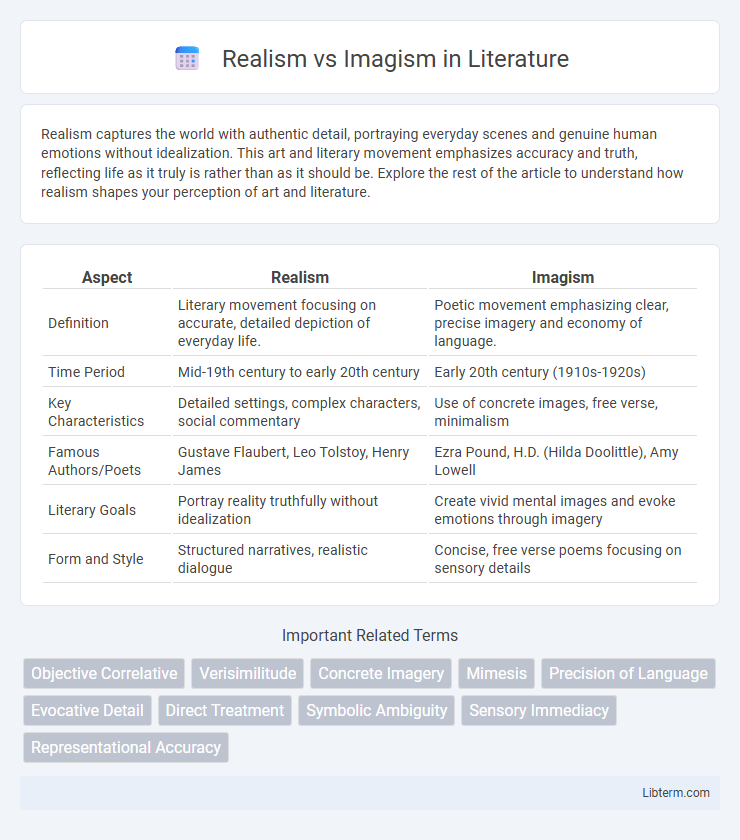Realism captures the world with authentic detail, portraying everyday scenes and genuine human emotions without idealization. This art and literary movement emphasizes accuracy and truth, reflecting life as it truly is rather than as it should be. Explore the rest of the article to understand how realism shapes your perception of art and literature.
Table of Comparison
| Aspect | Realism | Imagism |
|---|---|---|
| Definition | Literary movement focusing on accurate, detailed depiction of everyday life. | Poetic movement emphasizing clear, precise imagery and economy of language. |
| Time Period | Mid-19th century to early 20th century | Early 20th century (1910s-1920s) |
| Key Characteristics | Detailed settings, complex characters, social commentary | Use of concrete images, free verse, minimalism |
| Famous Authors/Poets | Gustave Flaubert, Leo Tolstoy, Henry James | Ezra Pound, H.D. (Hilda Doolittle), Amy Lowell |
| Literary Goals | Portray reality truthfully without idealization | Create vivid mental images and evoke emotions through imagery |
| Form and Style | Structured narratives, realistic dialogue | Concise, free verse poems focusing on sensory details |
Introduction to Realism and Imagism
Realism emerged in the mid-19th century as a literary movement emphasizing accurate, detailed representation of everyday life and society, often highlighting ordinary characters and social conditions. Imagism developed in the early 20th century as a modernist poetry movement prioritizing clarity, precision, and vivid imagery, advocating for economy of language and free verse. Both movements shifted away from romanticized narratives, with Realism rooted in objective observation and Imagism in symbolic, sensory experience.
Historical Background of Realism
Realism emerged in the mid-19th century as a reaction against Romanticism, emphasizing the depiction of everyday life and ordinary people with accurate detail. Rooted in the social and political changes brought by the Industrial Revolution, Realist writers sought to portray the struggles of the working class and challenge idealized narratives. This literary movement influenced narratives that prioritized objectivity, social critique, and the exploration of societal conditions over imagination or abstraction.
Emergence of Imagism
Emergence of Imagism marked a pivotal shift from Realism by emphasizing precise, clear images and economy of language, rejecting the detailed descriptive style characteristic of Realist literature. Imagist poets like Ezra Pound and H.D. promoted direct treatment of the subject and avoided verbosity, fostering a new poetic clarity that contrasted with Realism's broader narrative scope. This movement influenced modern poetry by prioritizing visual clarity and emotional intensity, reshaping 20th-century literary expression.
Core Principles of Realism
Realism centers on accurate, detailed representation of everyday life and ordinary people, emphasizing objective observation without idealization or romanticism. Core principles include a commitment to fidelity in depicting social realities, character complexity shaped by environment and heredity, and avoiding sensationalism or speculative elements. This literary movement seeks to portray the truth of human experience through precise descriptions and a focus on plausible events.
Key Tenets of Imagism
Imagism emphasizes clarity, precision, and economy of language, rejecting the elaborate descriptions typical of Realism. It advocates for direct treatment of the "thing," use of exact words, and musical rhythm in free verse, aiming to capture vivid images in few words. Central to Imagism is the belief that poetry should evoke emotion through visual and sensory detail rather than abstract ideas or moral narratives.
Major Figures in Realist Literature
Major figures in Realist literature include authors such as Gustave Flaubert, Leo Tolstoy, and Henry James, who emphasized detailed character development and faithful representation of everyday life. These writers portrayed middle-class experiences and social environments with psychological depth and moral complexity. Their works contrast with Imagism's emphasis on concise, vivid imagery and economy of language, highlighting the narrative and descriptive richness central to Realism.
Prominent Imagist Poets
Prominent Imagist poets such as Ezra Pound, H.D. (Hilda Doolittle), and Amy Lowell emphasized clarity, precision, and economy of language, contrasting sharply with the broader narrative and detailed descriptions typical of Realism. Imagism sought to capture exact visual images and moments through concise language, often using free verse and avoiding the elaborate symbolism or emotional excess common in Realism. This movement significantly influenced modern poetry by prioritizing vivid imagery and a directness that Realism's more expansive storytelling did not typically pursue.
Stylistic Differences Between Realism and Imagism
Realism employs detailed, straightforward language to depict everyday life and social conditions with objective clarity, emphasizing character development and narrative coherence. Imagism, in contrast, prioritizes precise, vivid imagery and economy of words, using free verse and concise, sensory language to evoke emotions and moments rather than elaborate plots. The stylistic hallmark of Imagism lies in its emphasis on visual clarity and direct treatment of the subject, diverging from Realism's extensive descriptive passages and linear storytelling.
Impact on Modern Literature
Realism and Imagism significantly shaped modern literature by emphasizing different narrative techniques and thematic priorities. Realism focused on detailed depictions of everyday life and complex characters, fostering a grounded and relatable storytelling approach. Imagism, with its brevity, precise language, and vivid imagery, revolutionized poetic expression by prioritizing clarity and emotional intensity over elaborate description.
Conclusion: Realism vs Imagism—Contemporary Relevance
Realism and Imagism offer contrasting approaches to literary representation, with Realism emphasizing detailed, objective depictions of everyday life, while Imagism prioritizes clarity, precision, and vivid imagery. Contemporary literature continues to draw on Realism's commitment to social truth alongside Imagism's techniques for enhancing sensory experience and emotional depth. The ongoing relevance of both movements lies in their combined influence on modern narratives that seek authenticity through nuanced observation and powerful, economical language.
Realism Infographic

 libterm.com
libterm.com